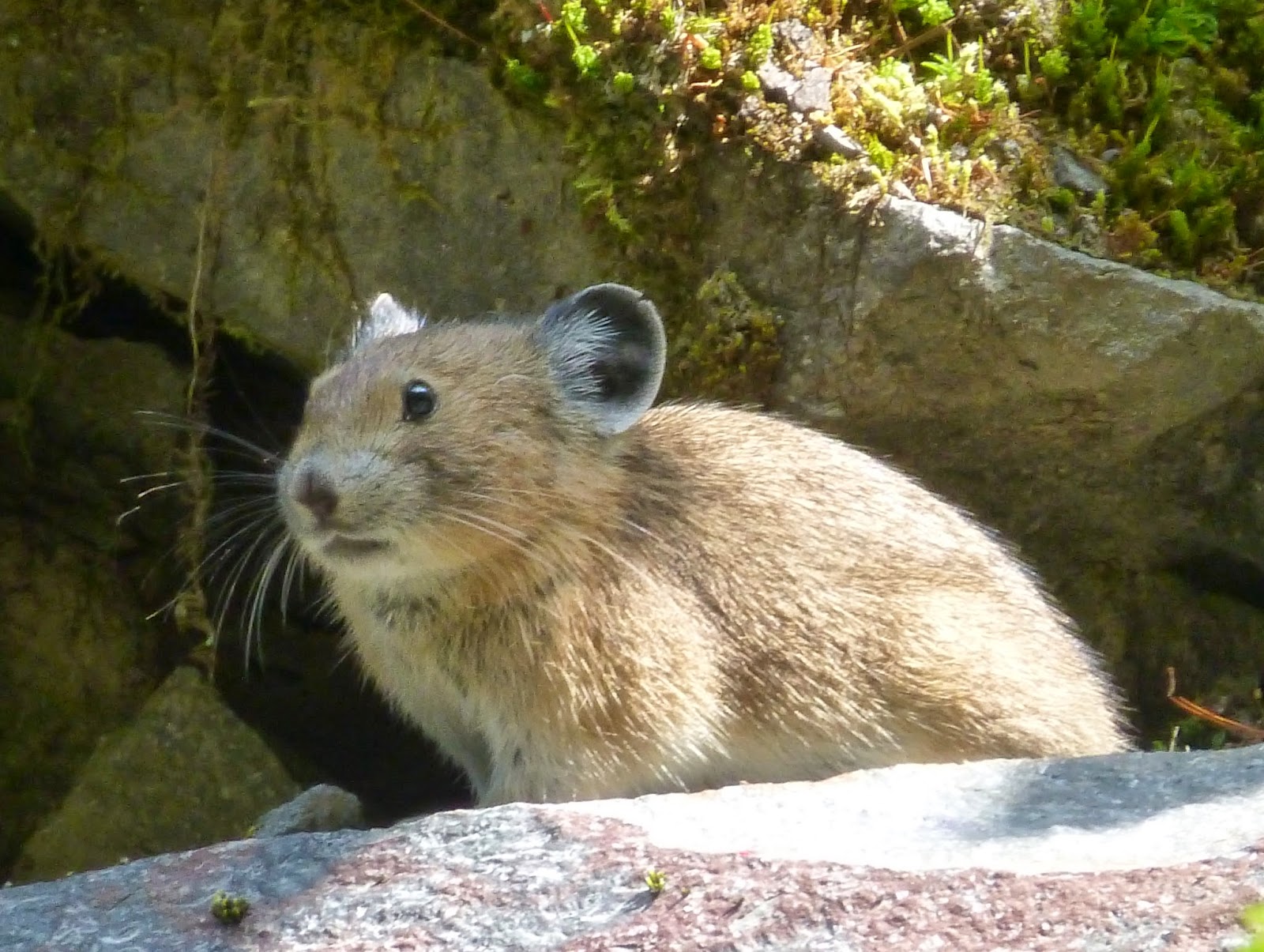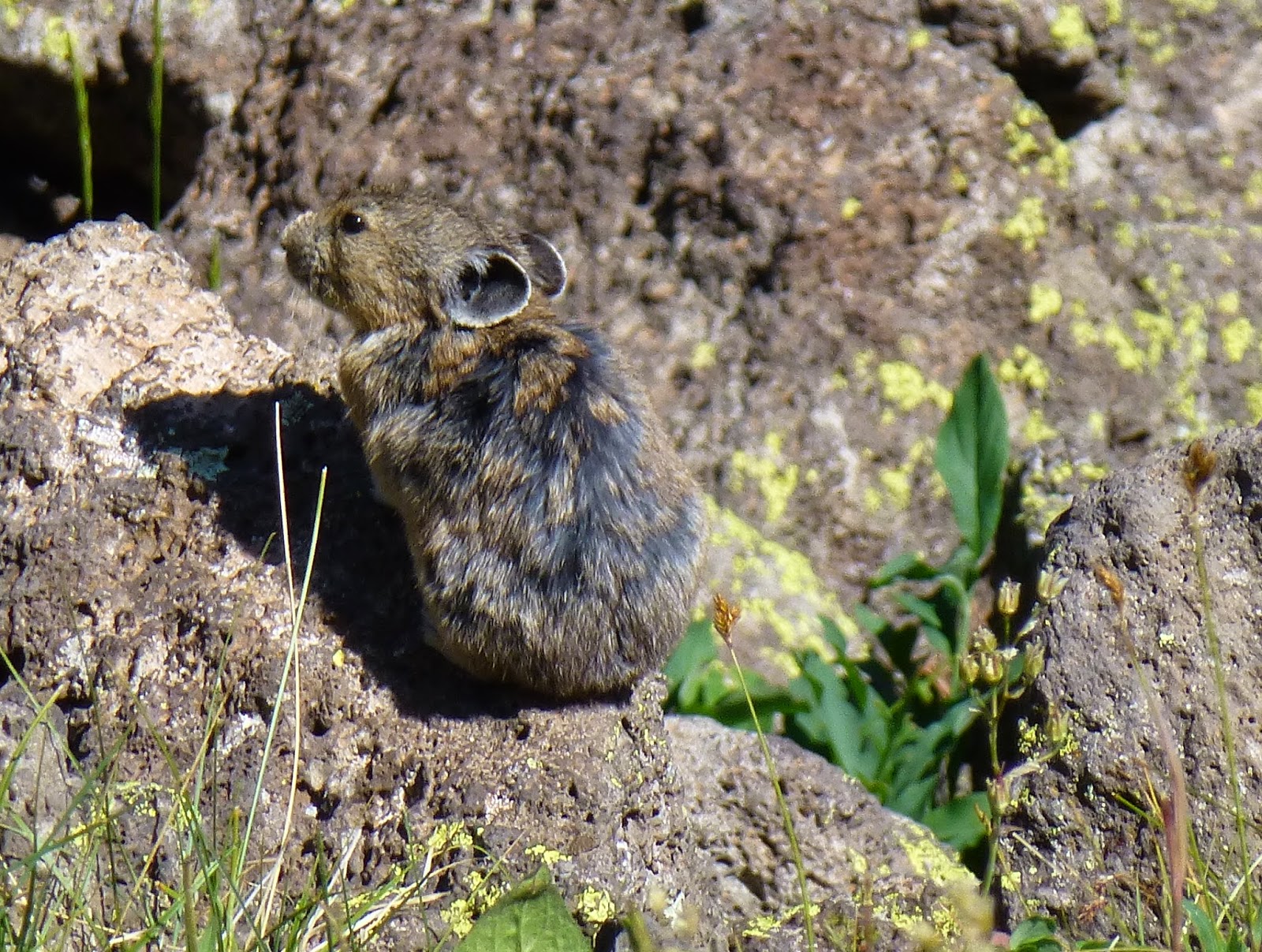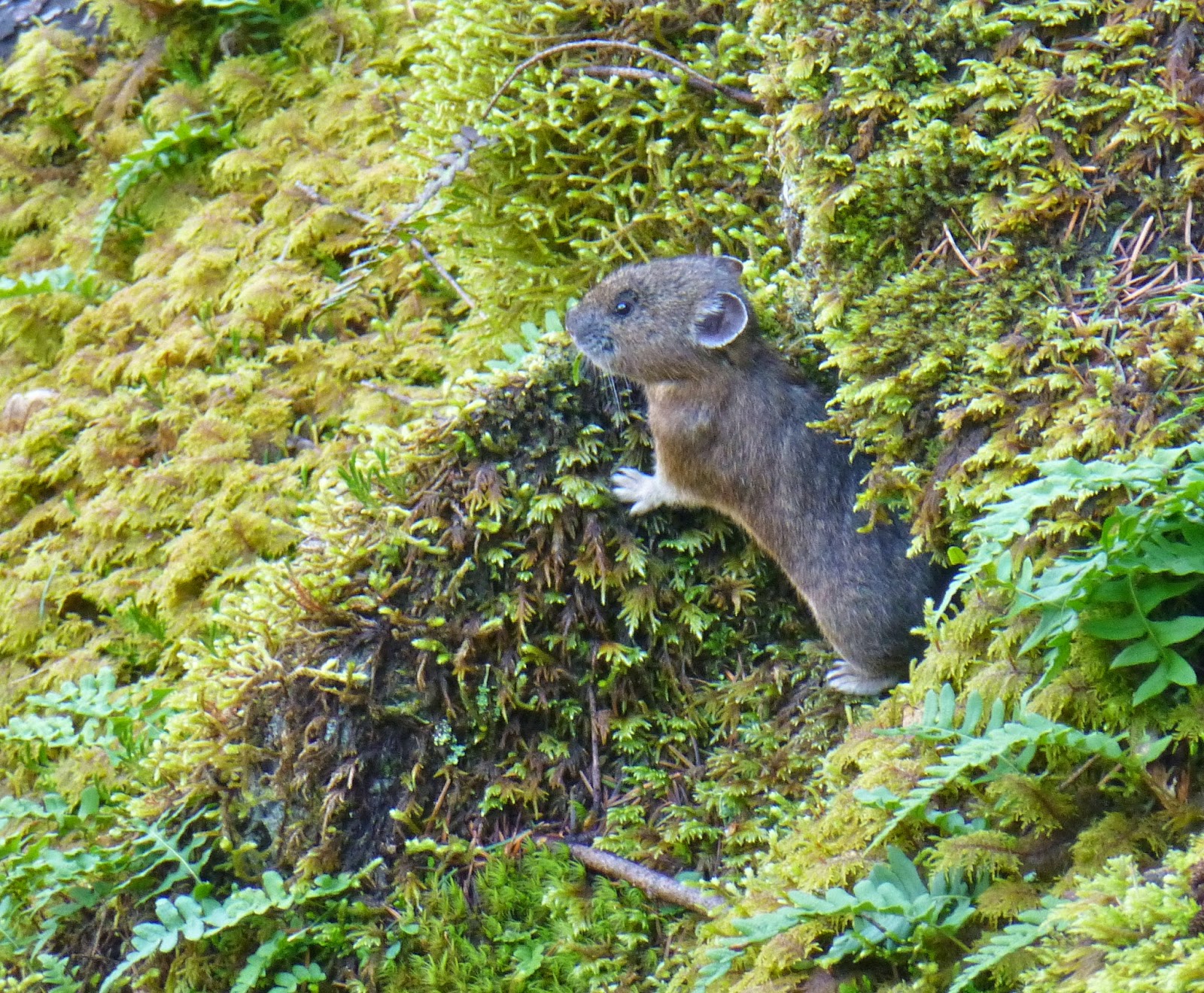Just a warning. I keep a pretty decent pace when I’m hiking up a mountain, but any time we pass a nice boulder field, I’m going to pull up short and go meeeep. There’s nothing you need to do about it. I’m just sending out a little hey-there to one of my favorite critters. Sometimes one meeeeps back.
We loved pikas even before we spent a delightful few minutes in Glacier Park watching one totally punk our dog. Boomer was an optimistic mutt by nature and was much energized by the prospect of nailing a rodent even though she went seventeen years without ever getting close. Bless her fuzzy little heart, she’s always thought today was the day. We could all use an attitude like that, and it’s not like there was ever a chance she’d do any lasting harm. We didn’t even bother explaining to her that pikas were lagomorphs and not rodents–she was not a detail dog. Meeeep! went the pika, and Boomer scampered after it, and it ducked into a hidey hole in the rocks followed by Boomer’s head. The pika would reappear a few feet away, turn to the dog’s avid, quivering tail, go meeeep again, Boomer would snap her head up so fast she beaned herself on the rock, and tear after the pika again. The pika had things to do so we didn’t let this go on too long, but I can’t help but think it was enjoying itself. I think it had a little grin.
So when Dave and I had the opportunity to go to a lecture on pikas downtown, we did. That’s when we learned that if it was a grin on the pika, it was a shit-eating one. Pikas are among the animals that are big on eating leftovers, after running the original meal through the system once. It’s one way to contend with a vegetarian diet, because plant cellulose is hard to digest; chewing the cud is another. Eating one’s own shit works fine for the bunny family because, conveniently enough, they are incapable of throwing up. Still, the whole business is another mark in the plus column for being a baconivore.
The pika spends most of its time in higher-altitude rock piles. He eats plants (twice) and gathers more to make hay for the winter. By the time it gets really cold the pika should have a pretty good hay pile going from which he will eat all winter. He does not hibernate. He’d rather eat dried-up old flowers (twice) than take a nice nap. Tastes differ. However it is a remarkable thing that he knows to make his hay pile. Personally, I don’t anticipate anything vividly enough to be that prepared. If I’m warm when I leave the house, I won’t take a sweater with me even if the temperature is sure to drop, because I can’t imagine being cold. (I have evolved to accompany a man who will give me his jacket.) But I’m not a pika. Also, I eat bacon.
They’re particular about their location. They like things cool. If for some reason the world should be getting warmer, they don’t have a ton of options. They can go higher up the mountain, but they’re not really set up to migrate. As a result the pika appears to be in decline. People who study them are looking carefully at the margins of their habitat. The edges of their range represent the conditions that are just tolerable for them, so if they begin to disappear along the margins, it’s pretty clear their habitable range is shrinking.
No one’s gotten anywhere with trying to get the pika listed as endangered. Because then we’d be legally obligated to protect them, and the only thing we could do for them is try to halt climate change, and that means we have to start doing a lot of things differently, so–it’s sayonara, pika.
Meanwhile, the same techniques can be applied to humans to see if we’re in trouble: check conditions along the margins. Not those poor saps in the little island nations that are being submerged–we consider them marginal people to begin with. Trouble is, we don’t recognize our own margins anymore. We blast the air conditioner. We jack up the thermostat. We think water comes in bottles from Nestle. By the time we figure out there’s no more mountain to climb up, it’s too late. There’ll be nothing left to do but eat shit and die.



god, you kill me. love pikas.
And red efts, as I recall. My kind of girl!
I haven't seen a pika since I left Colorado. I know they are around the mountains up here in the PNW, because I hear them. It won't be the same without our shit-eating friends. 🙁
Have you tried meeeping for them?
One learns so much at Murrmurrs.
…and only so much.
That's for sure! I had never even heard of pikas. Cute little things, no matter their diet.
Especially when they meeep. Their little mouths in an "O."
I've tried and tried but I can't go "meeep" with an "O" mouth … yet more proof that pikas rock.
It's times like this that I feel really lucky to be dead by the time these critters (and so many others) will be totally gone. At least I hope I'm gone by then.
It's damn hard to watch. I don't think any of us have too long, really.
You had me at "baconivore"! We've still got pikas up here in the Rockies, too – cute little guys. And some days I consider moving a little higher up the mountains myself…
You're easy! I always yearn for higher mountains rather than a bland shore. Don't know if it's my inner Norwegian or if I have a bit of pika in me. I do have an overbite.
And then there was the day my dog Otis DID manage to catch a squirrel (WTF? how' he managed that I'll never know!)…and eat it…and had to ride in my lap all the way home because the back of the truck was full of firewood. At least squirrels aren't in the bunny family.
Frankly, if you'd like to send over your wonder Otis,
Dave would be thrilled with any number of squirrels he'd care to cull. Good boy. Good boy.
Amen on that!
Pikas have the best ears in the animal kingdom!
How about owl ears? You can see their eyeballs through them. Okay, that's spooky.
Powerful article, Murr.
Thank you, Lyn.
They are awfully like hamsters in their cuteness, if not in their classification. And wikipedia says that most of their vocalizations are for "haypile defense". I wish they could meeep their way to some habitat defense too.
They're sort of doing it, here. The last photo I have up there (I took them all! Yay me!) is of a low-elevation pika. They do not like it warm, but the big mossy rock slopes are able to keep them cool enough. Also, they're apparently harvesting moss, which is not easy to digest, but which is so plentiful they don't run out. I think the Columbia River Gorge is the only place like that that they have been found in.
Oh, and that's practically at sea level…
So it's possible they're evolving…great news! As long as it happens fast enough to save them.
This tiny little population should squeak through for a while. No idea how long our mossy green will last.
Sigh. I too like it cool. And don't eat bacon. Not a fan of double digestion, so I suspect I will have to just die, covered in shit perhaps, but not consuming it.
Hey. Tastes differ.
I've never heard of these cute little Pikas before, it's a shame they're on the decline. Like so many others whose habitat is fast disappearing. (orang-utans) Perhaps they could build a reserve area for them?
I prefer cool too, so use the air conditioner in summer, but not so much in winter. A little bar heater to warm the bathroom before I shower is usually enough then. So I'm sort of doing a bit to help against climate change, just not enough. But there are many who do nothing to help.
Gosh, they'd have to pile up stones and air-condition them, and then we're right back in the middle of the problem.
This is the second time I've "published" a comment on your blog to have it disappear. What's with that?
I've seen pikas in the Washington Cascades and the San Juan foothills near Cortez, Colorado.
Dogs should not be allowed to harass any wild animal, whether or not they are capable of catching it. Other than that, thanks for the article on these guys. Human-caused climate change and habitat destruction is an affront to the Creator.
I totally agree. In my defense, it was thirty years ago, and I was a young pup myself. Why, thirty years ago, I probably would have let a cat roam outside, too.
I'm in complete agreement with Jono on this one. I don't want to see any more devastation than I've already seen.